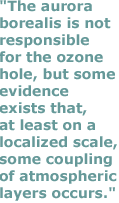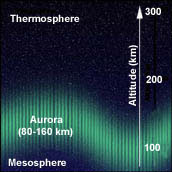

 |
by Dan Whipple February 22, 2000 |
||
|
"Remote sensing is really the only way to study the mesosphere on a global basis," says David Siskind, a research physicist with the U.S. Naval Research
Laboratory. "The UARS [Upper Atmosphere Research Satellite] satellite has
revolutionized our view of the mesosphere. It's been a tremendous boon to
research at those altitudes (90-100 km above the Earth's surface) because the UARS satellite has a lot of instruments
capable of remotely sensing mesospheric altitudes."
|
  This graphic shows the approximate location of the Aurora Borealis in relation to the mesosphere and thermosphere. (Image adapted from Robert Simmon, Goddard Space Flight Center). Researchers at NASA's Goddard Space Flight Center use UARS data to study the coupling of atmospheric layers. For more information, visit the Goddard Space Flight Center DAAC (now named the GSFC Earth Sciences DAAC). The image in the title graphic shows the tail of the Space Shuttle Discovery over the Aurora Australis. |
Siskind and his group were the first to test one of the new generation
two-dimensional chemistry models against mesospheric observations of trace
constituents. A two-dimensional (2D) model represents the atmosphere by
considering vertical and latitudinal (north-south) coordinates, Siskind explains.
Two-dimensional models are the simplest type of model that can realistically
handle both chemical and meteorological effects. Combining relative simplicity
with detailed physics and chemistry, 2D models have long been the workhorses of
stratospheric science, and were the basis for many ozone assessments.
An example of a more complicated model is a three-dimensional (3D) model, which includes an additional longitudinal (east-west) coordinate. A practical example of a 3D model is a weather forecasting model. "The model we used was one of the first to combine some of the meteorological effects normally only considered in a 3D model, with the standard two-dimensional model. This 'next generation' 2D model has sometimes been called a two-and-one-half-dimensional model," Siskind says. The research aimed at discovering to what extent compounds produced in the thermosphere—which many people consider outer space—migrate to the middle and lower atmosphere and react with chemicals there. For instance, "nitric oxide has been postulated to do just this," he said. "We studied the coupling between different layers of the atmosphere. The overall question is, 'To what extent is stratospheric ozone sensitive to processes occurring, for example, in the aurora borealis?'" An early theory hypothesized that nitric oxide produced in the aurora borealis was related to creation of the ozone hole, Siskind says. "It was never a mainstream theory," he says, "but some of the processes in the theory do occur. The aurora borealis is not responsible for the ozone hole, but some evidence exists that, at least on a localized scale, some coupling of atmospheric layers occurs." "While coupling is confirmed, it may be less than previously estimated," Siskind said. For example, Siskind's results indicated coupling only in the Southern and not the Northern Hemisphere, a phenomenon that remains to be explained. The result surprised scientists. Siskind suspects that different meteorological conditions might account for the different couplings between aurora and stratosphere seen in the Northern and Southern Hemispheres. His research indicates that horizontal mixing is the mechanism whereby nitric oxide is carried from dark, winter polar regions to lower latitudes, where strong sunlight breaks the chemical bonds by photodissociation. (Photodissociation is the process by which sunlight breaks complex molecules in the atmosphere into simpler molecules). This mixing is believed to be more rapid in the Northern Hemisphere and therefore may lead to more destruction of nitric oxide, he says. The researchers' next step is to see how the coupling between aurora and stratosphere varies from year to year. "For example, does it vary in concert with the sunspot cycle? Our calculations were for idealized conditions; now we are going to incorporate year-to-year variability in sunspot activity into the model," Siskind says. |
|